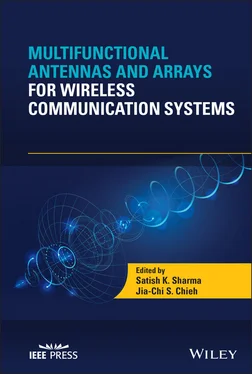1 Cover
2 Title Page
3 Copyright Page
4 Dedication Page
5 List of Contributors
6 Preface
7 Acknowledgements
8 1 Introduction 1.1 Introduction 1.2 Antenna: an Integral Component of Wireless Communications 1.3 Antenna Performance Parameters 1.4 Antenna Types 1.5 Multifunctional Antennas 1.6 Reconfigurable Antennas 1.7 Frequency Agile/Tunable Antenna 1.8 Antenna Measurements 1.9 Conclusion References
9 2 Frequency Reconfigurable Antennas 2.1 Introduction 2.2 Mechanism of Frequency Reconfigurability 2.3 Types of FRAs 2.4 FRAs in the Future: Applications in Emerging Technologies 2.5 Conclusion References
10 3 Radiation Pattern Reconfigurable Antennas 3.1 Introduction 3.2 Pattern Reconfigurable by Electronically Changing Antenna Elements 3.3 Pattern Reconfigurable by Electronically Changing Feeding Network 3.4 Mechanically Controlled Pattern Reconfigurable Antennas 3.5 Arrays and Optimizations 3.6 Reconfigurable Wearable and Implanted Antennas 3.7 Conclusion References
11 4 Polarization Reconfigurable Antennas 4.1 Introduction 4.2 Polarization Reconfiguration Mechanism Using RF Switches 4.3 Solid‐State RF Switch‐Based Polarization Reconfigurable Antenna 4.4 Mechanical and Micro‐electro‐mechanical (MEMS) RF Switch‐Based Antennas 4.5 Switchable Feed Network‐Based Polarization Reconfiguration 4.6 Polarization Reconfigurable Antennas Using Metasurface 4.7 Other Methods to Create Polarization Reconfigurable Antennas 4.8 Conclusion References
12 5 Liquid Metal, Piezoelectric, and RF MEMS‐Based Reconfigurable Antennas 5.1 Introduction 5.2 Liquid Metal – Frequency Reconfigurable Antennas 5.3 Liquid Metal – Pattern Reconfigurable Antennas 5.4 Liquid Metal – Directivity Reconfigurable Antennas 5.5 Piezoelectric – Pattern Reconfigurable Array 5.6 RF MEMS – Frequency Reconfigurable 5.7 RF MEMS – Polarization Reconfigurable 5.8 RF MEMS – Pattern Reconfigurable 5.9 Conclusion References
13 6 Compact Reconfigurable Antennas 6.1 Introduction 6.2 Reconfigurable Pixel Antenna 6.3 Compact Reconfigurable Antennas Using Fluidic 6.4 Compact Reconfigurable Antennas Using Ferrite and Magnetic Materials 6.5 Metamaterials and Metasurfaces 6.6 Conclusion References
14 7 Reconfigurable MIMO Antennas 7.1 Introduction 7.2 Reconfigurable Antennas for MIMO Applications 7.3 Isolation Techniques in MIMO Antennas 7.4 Pattern Diversity Scheme 7.5 Reconfigurable Polarization MIMO Antenna 7.6 MIMO Antenna Performance Parameters 7.7 Some Reconfigurable MIMO Antenna Examples 7.8 Conclusion References
15 8 Multifunctional Antennas for 4G/5G Communications and MIMO Applications 8.1 Introduction 8.2 MIMO Antennas in Multifunctional Systems 8.3 MIMO Antennas in Radar Systems 8.4 MIMO Antennas in Communication Systems 8.5 MIMO Antennas for Sensing Applications 8.6 MIMO Antennas for 5G Systems 8.7 Massive MIMO Array 8.8 Dielectric Lens for Millimeter Wave MIMO 8.9 Beamforming in Massive MIMO 8.10 MIMO in Imaging Systems 8.11 MIMO Antenna in Medical Applications 8.12 Conclusion References
16 9 Metamaterials in Reconfigurable Antennas 9.1 Introduction 9.2 Metamaterials in Antenna Reconfigurability 9.3 Metamaterial‐Inspired Reconfigurable Antennas 9.4 Metasurface‐Inspired Reconfigurable Antennas 9.5 Conclusion References
17 10 Multifunctional Antennas for User Equipments (UEs) 10.1 Introduction 10.2 Lower/Sub‐6 GHz 5G Band Antennas 10.3 5G mm ‐Wave Antenna Arrays 10.4 Collocated Sub‐6 GHz and mm ‐Wave 5G Array Antennas 10.5 RF and EMF Exposure Limits 10.6 Conclusion References
18 11 DoD Reconfigurable Antennas 11.1 Introduction 11.2 TACAN 11.3 Sea‐Based X‐Band Radar 1 (SBX‐1) 11.4 The Advanced Multifunction RF Concept (AMRFC) 11.5 Integrated Topside (InTop) 11.6 DARPA Arrays of Commercial Timescales (ACT) 11.7 AFRL Transformational Element Level Array (TELA) 11.8 Conclusion References
19 12 5G Silicon RFICs‐Based Phased Array Antennas 12.1 Introduction 12.2 Silicon Beamformer Technology 12.3 LO‐Based Phase Shifting 12.4 IF‐Based Phase Shifting 12.5 RF‐Based Phase Shifting 12.6 Ku‐Band Phased Arrays Utilizing Silicon Beamforming Chipsets 12.7 Ku‐Band Phased Arrays on ROHACELL Utilizing Silicon Beamforming Chipsets 12.8 Ku‐Band Phased Arrays with Wide Axial Ratios Utilizing Silicon Beamforming Chipsets 12.9 28 GHz Phased Arrays Utilizing Silicon Beamforming Chipsets 12.10 Phased Array Reflectors Utilizing Silicon Beamforming Chipsets 12.11 Conclusion References
20 Index
21 End User License Agreement
1 Chapter 1 Table 1.1 PIN diode states for reconfiguring the lower frequency bands while ...
2 Chapter 3Table 3.1 Dimensions of polarization reconfigurable cavity‐backed slot antenn...Table 3.2 Different polarization states.Table 3.3 Measured maximum gain and FBR of antennas with PIN diodes and FET s...Table 3.4 Different cases of beam switching using different phases on each pr...Table 3.5 Antenna performance and SAR simulations.
3 Chapter 4Table 4.1 Polarization sense of the proposed antenna for four combinations of...Table 4.2 Polarization sense of the E‐shaped proposed antenna in zero for fou...Table 4.3 State of the ports, diodes, and their result on the radiation polar...Table 4.4 Operating states of reconfigurable antenna.Table 4.5 Measured loss for the PFN for the linear and circular polarizations...Table 4.6 Polarization states by status of the DC biases.Table 4.7 Polarizations by different feeding ports of the four LP antenna ele...
4 Chapter 5Table 5.1 Possible radiation pattern modes from [3] showing states of the liq...
5 Chapter 6Table 6.1 Directivity, gain, antenna efficiency, and aperture efficiency for ...Table 6.2 The optimum gain achieved for different frequencies, degree of arri...Table 6.3 The resonance frequency of pixel antenna (GHz).Table 6.4 Bandwidth and efficiency of the pixel antenna in different states v...Table 6.5 Permittivity and permeability of the magnetic ink.Table 6.6 Gain and resonance frequency changes due to different levels of bia...Table 6.7 Measured antenna performance at two frequencies of operation of the...
6 Chapter 7Table 7.1 Average and 95% outage channel capacity (bit/s/Hz).Table 7.2 Design parameters of MIMO antenna.
7 Chapter 11Table 11.1 Performance summary from [11].
1 Chapter 1 Figure 1.1 The importance of antenna in a wireless communication system. Figure 1.2 Some antenna types generated through Antenna Design Kit in Ansys ... Figure 1.3 Antenna performance shown using (a) reflection coefficient magnit... Figure 1.4 (a) Top view photograph of a frequency tunable concentric circula... Figure 1.5 (a) Geometry of the proposed reconfigurable PIFA radiating elemen... Figure 1.6 Surface current distribution for (a) 780 MHz in lower frequency b... Figure 1.7 Comparison of the simulated (solid lines) and measured (dash line... Figure 1.8 The simulated (solid lines) and measured (dash lines) total anten... Figure 1.9 Simulated (a, c, e, g) and measured (b, d, f, h) near‐omnidirecti... Figure 1.10 Simulated (a, c, e, g) and measured (b, d, f, h) near‐omnidirect... Figure 1.11 Antenna geometry with varactor diode and biasing network. Figure 1.12 Design parameters for the low (right) and high bands (left). Figure 1.13 Surface current distribution with capacitance of 1.6 pF: (a) 810... Figure 1.14 Photograph of the fabricated single‐feed dual band antenna: (a) ... Figure 1.15 Vector network analyzer (VNA) can be used for measurement of the... Figure 1.16 Antenna testing in anechoic chamber at the Antenna and Microwave...
2 Chapter 2 Figure 2.1 (a) Top and bottom views of the frequency reconfigurable Spirogra... Figure 2.2 Ansys HFSS model of the SPMA frequency reconfigurable antenna: (a.
Читать дальше












